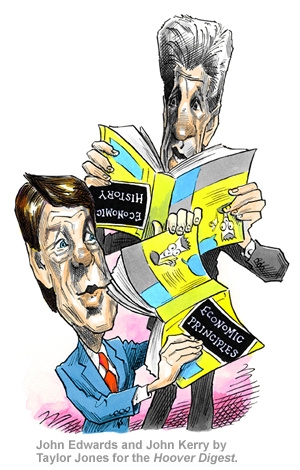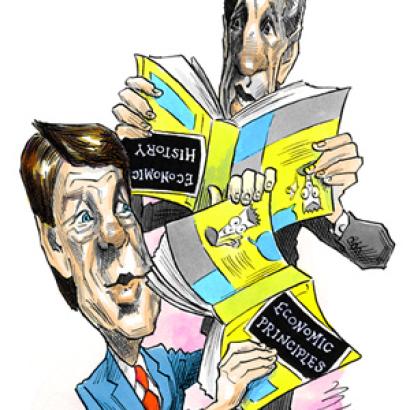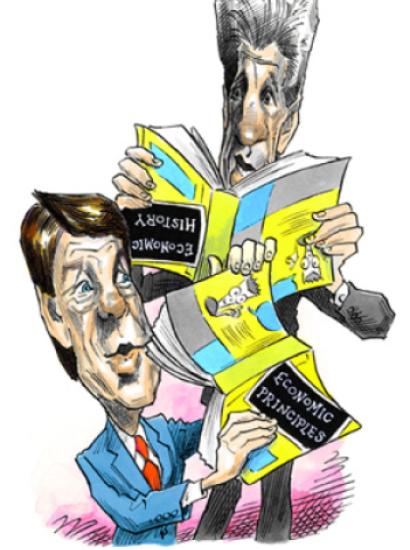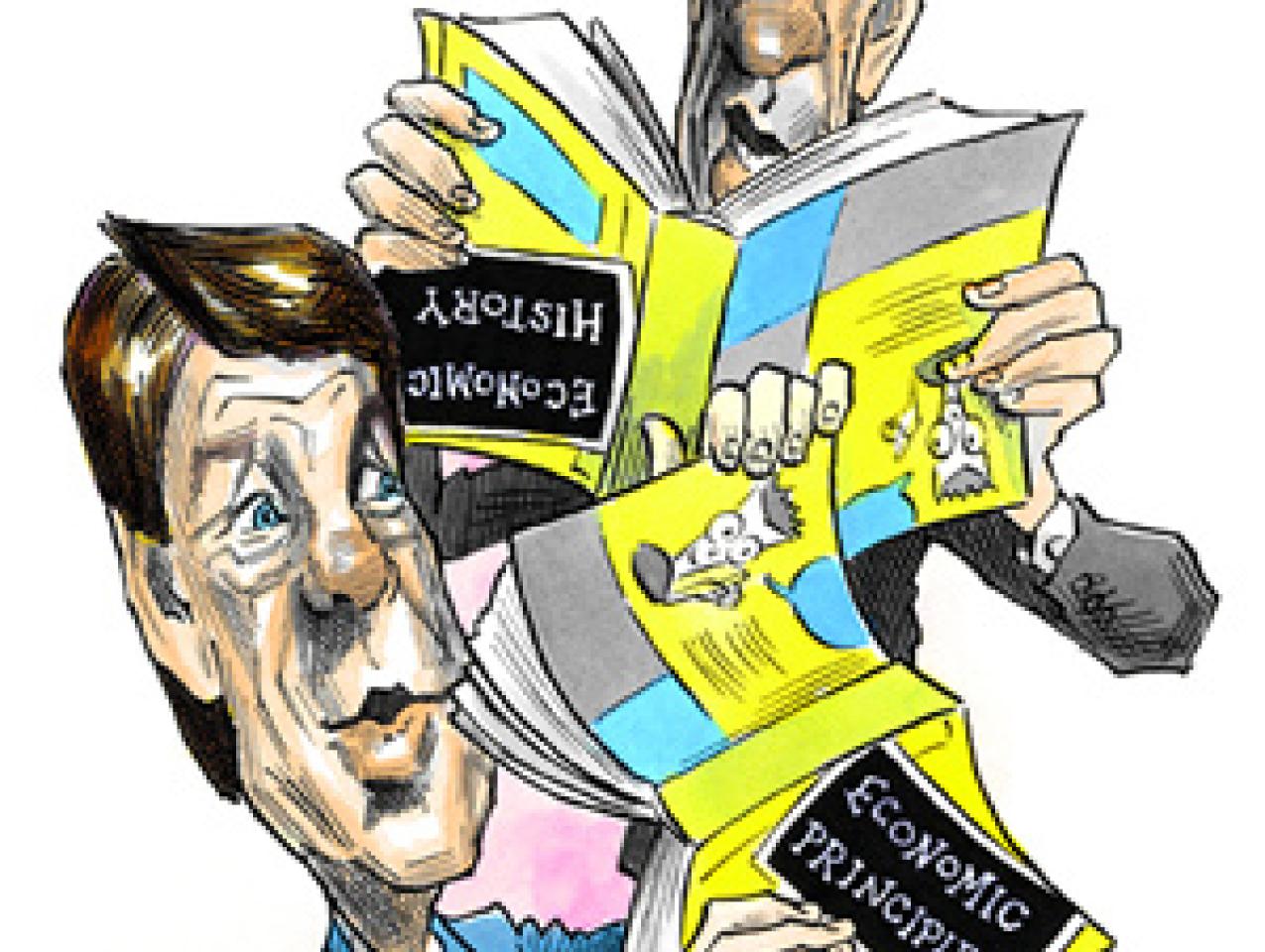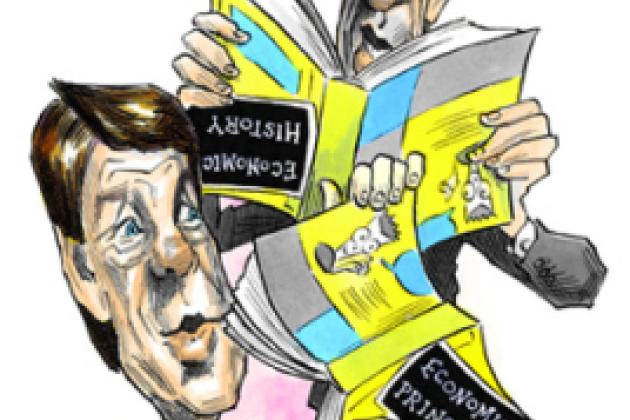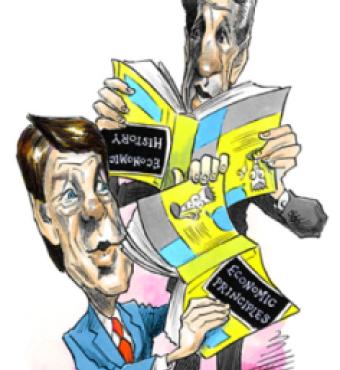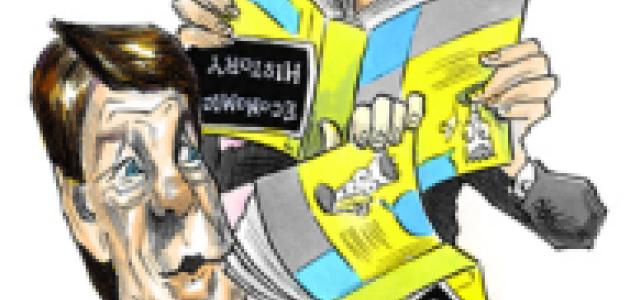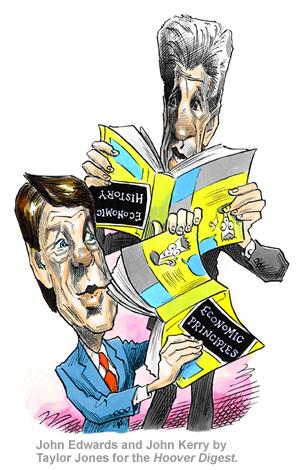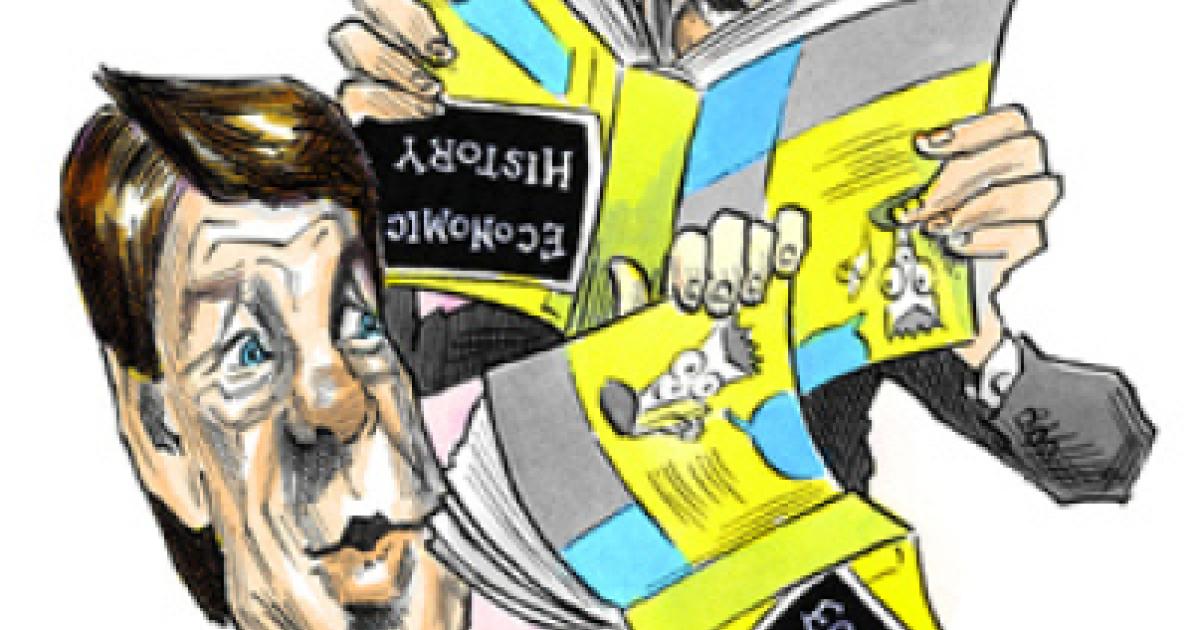- Campaigns & Elections
- Politics, Institutions, and Public Opinion
Teaching introductory economics to hundreds of freshmen here at Stanford, it was dismaying to see the usual election-year partisan exaggeration, distortion, and hyperbole morph into outright economic illiteracy. To be fair, all candidates and all presidents wind up saying some things that make economists cringe, usually put into a speech by political advisers unconstrained by economic facts or principles. But, from convenient economic-historical amnesia, to refusal to acknowledge basic facts, to suspension of basic economic principles, what we heard on the campaign trail was truly remarkable, especially from the Kerry-Edwards campaign, which accused Bush and Cheney of being “out of touch with economic reality.” Most of the Kerry-Edwards campaign’s policy prescriptions not only wouldn’t pass muster but were the opposite of what we teach in introductory economics.
Let’s start with the description of the economy, which the Kerry-Edwards campaign claimed was the “worst economy since Hoover.” Recall that President Hoover was in office in October 1929, when the stock market crashed and the Great Depression began. The unemployment rate, at a time when very few families had two earners and there was a much smaller safety net, reached almost 25 percent by 1933; indeed, it was still at 15 percent under FDR in 1939. The current unemployment rate is 5.4 percent, less than the average for the last 30 years, about what it was when President Clinton ran for reelection in 1996, though certainly above the 4.2 percent it had been when President George W. Bush first assumed office.
That low unemployment rate was the result of a mini-bubble in the labor market accompanying a maxi-bubble in the stock market. Few economists believe we can push the unemployment rate permanently back down to 4.2 percent without accelerating inflation and risking much worse economic harm. By President Clinton’s last year in office, inflation had doubled to 3.4 percent, the Fed was raising interest rates, the bubble had burst, and the economy was sliding toward recession.
Although there certainly are pockets of hardship (if you are unemployed, you are 100 percent unemployed, not 5.4 percent unemployed), it is truly bizarre to claim this is the worst economy since Hoover. In 1980, President Carter’s last year, the unemployment rate was well above 7 percent; the contemporaneous inflation rate was over 12 percent; and the so-called misery index—the sum of the two—was 20 percent, two and a half times the current misery index of 7.9 percent! In fact, the misery index has been lower only five times in the last 35 years.
A deeper question is how high above the normal unemployment rate 5.4 percent really is; many economists believe the rate of unemployment consistent with the normal matching of people to jobs in the economy runs around 5 percent. Indeed, the Congressional Budget Office (CBO) estimate of the rate of unemployment consistent with stable inflation, a closely related concept, is only slightly below where we are now. Thus measured by the amount of unemployment above what is normal in a market economy that is always reallocating resources, 5.4 percent unemployment may be only about one-sixth as bad as it was in 1980, and even less relative to several other episodes. And, of course, the economy is growing at a decent clip, real after-tax incomes are rising, and inflation and interest rates are low. In any event, an objective observer would have to conclude that the economy is doing at least average and improving. In light of the bursting of the stock market bubble, the recession, and the terrorist attacks, this is pretty impressive. Again, credit goes primarily to our flexible market economy, but aggressive monetary and fiscal policies were a big help.
The Kerry-Edwards campaign claimed that the Bush tax cuts did a lot of economic harm. This is exactly backward. Although in the long run deficits do matter, as well as the level and structure of spending and taxes, war and recession are times when deficits naturally occur and can even be downright desirable. Most economists, myself included, believe we should rely primarily on monetary policy to deal with short-run problems in the economy because fiscal policy is usually a clumsy tool, prone to implementation lags, much more so than monetary policy. However, an important exception occurs in a potentially severe downturn when the Fed has used up most of the arrows in its quiver by lowering short-term interest rates close to zero. Remember, it was only a few years ago that there was serious concern about deflation, falling prices, and a Japanese-style lost decade, which would have made the debt problems of households, corporations, and governments far more severe and the conducting of monetary policy far more difficult.
The Bush tax cuts were one of the best-timed and most efficacious uses of fiscal policy ever, although it would have been better to have implemented all the rate cuts in 2001, rather than phasing them in slowly. Better still to have combined the tax cuts with effective control of future spending as the economy returned to full employment. But it is no coincidence that a moribund economy mired in a slow, uneven, uncertain recovery took off exactly when the 2003 tax cuts were passed.
Kerry and Edwards wanted to repeal the centerpieces: the reduction in the top two tax rates and the dividend and capital gains relief. They said it would have been better temporarily to provide larger rebates for lower- and middle-income people and dole out more cash to state and local governments. First, the evidence is that temporary tax rebates have very little stimulative effect. Second, the lower rates and dividend and capital gains relief moved us closer to an “optimal” tax base by significantly reducing the double taxation of saving and investment. Indeed, if the Kerry-Edwards concern was the potential long-run harm of deficits crowding out private capital formation, their proposal to raise taxes on private capital formation was very strange.
To be sure, the deficits (and lower tax rates) have longer-run consequences. The CBO projections of the president’s budget over the next decade show a debt-GDP ratio peaking at just above 40 percent in two or three years, then stabilizing below the post–World War II historical average and far below Euroland and Japan. This is hardly a debt spiraling out of control, leading to inflation fears fueling a financial crisis and economic calamity. It would be better to reduce the debt-GDP ratio over the next 10 years, preferably by controlling spending still further and by fostering still stronger economic growth. President Bush’s proposal for personal accounts in Social Security does have short-run costs and should be combined with other reforms. Kerry and Edwards explicitly ruled out all reforms in benefits, which left only tax increases or bigger deficits. As to Medicare, the president’s prescription drug program has some good reform elements but was not financed; Kerry and Edwards complained it wasn’t large enough, again leaving even larger tax increases or even larger deficits.
Over the next several decades, federal income taxes as a share of GDP under current law are scheduled to rise enormously. Real bracket creep, the alternative minimum tax, and other lesser factors will drive up the total federal tax burden by one-third relative to the long-run historical average. We will need continued spending control and tax cuts if we are to maintain our flexible, dynamic market economy.
The Kerry-Edwards campaign was no better at micro- than macroeconomics. Suggesting that it’s the government’s role to prevent any price from rising (tuition, gasoline, pharmaceuticals) is reminiscent of the former Soviet Union, where prices never went up but where there were never any goods available at those stable prices (the “true” prices were those in the black markets). The government’s responsibility, exercised through the Federal Reserve, is to use monetary policy to achieve the goal of overall price stability. Any economy worth participating in has some prices going up, others going down, some moving sideways at different times, depending on supply, demand, technological changes, events abroad, and so forth. The genius of our economy is that it is more adaptable to such changes than any other major economy. The overall consumer price index—which is widely known to overstate inflation—has risen at an annual average rate of just over 2 percent since Bush assumed office. Arithmetic requires that the prices of other goods must be going down (computers, consumer electronics, household appliances, cell phones), for which President Bush is no more responsible than for the price increases.
Finally (only because I’m running out of space), the Kerry-Edwards campaign blamed President Bush for the flu shot fiasco. Having just given the lecture on why firms shut down (when price doesn’t cover average variable cost, including normal profit), even my freshmen students caught on immediately that we went from five to two firms producing flu vaccine (and 25 to 5 for all vaccines) because the cost was driven up (by regulation and class-action litigation risks) and the price, down (government buying power). The Kerry-Edwards campaign, complaining of rip-offs, promised more of this in health care and prescription drugs. We grant temporary monopolies with patents for a reason: to encourage innovation. Most citizens would prefer a stream of new, privately produced prescription drugs in process to a lower-cost supply, vulnerable to disruption and a dried-up innovation pipeline. (There is a legitimate issue of the rest of the world free riding and U.S. consumers paying most of the bill for expensive R&D.)
The Kerry-Edwards campaign advisers may have been courting a narrow slice of the electorate in a few swing states, but they had their candidates sounding pretty foolish to the rest of us.
Economic policy should be aimed primarily at maximizing non-inflationary economic growth (the denominator, not just the numerator, of the debt-GDP ratio). That would require (1) the lowest possible tax rates; (2) rigorous spending control; (3) gradual Social Security and Medicare reform; (4) regulatory and litigation reform; (5) trade liberalization; and (6) sound monetary policy. That recipe is most likely to lead to rising living standards, low unemployment, better-paying jobs, and upward economic mobility for those who have not yet made it on the economic ladder. It would also keep the debt-GDP ratio well under control.
President Bush promised a more modest role of government, trade liberalization (for example, supporting the Doha round), a lighter hand of government regulation, reining in frivolous litigation, slow growth of government spending, and lower taxes: in short, about the right mix, although one can argue with the details. To be sure, the first term was far from perfect (too much spending, steel tariffs, etc.). Kerry and Edwards, on the other hand, proposed quite a bit more spending, higher taxes, especially on capital formation, greater government regulation, and restrictions on global trade. Avoiding the hyperbole that flew around on the campaign trail, that plan would have been a sizable—not gigantic—step toward a Western European– style social welfare state, with its concomitant double-digit unemployment and economic stagnation. So which candidates were out of touch with economic reality?
An earlier version of this essay appeared in the Wall Street Journal on October 26, 2004.
Available from the Hoover Press is Frontiers of Tax Reform, edited by Michael J. Boskin. To order, call 800.935.2882 or visit www.hooverpress.org.
